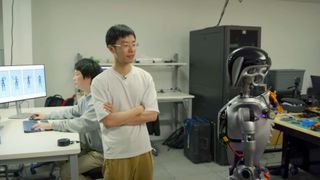Nvidia has officially revealed its next GPU, but the company wants to chat AI robots first before the RTX 5090
Someone call Will Smith

Nvidia has officially revealed its next-gen GPU, codename Blackwell, providing us with a glimpse at the tech that could power the RTX 5090. However, you might want to curb your enthusiasm if you were hoping to hear more about the future of GeForce graphics cards, as the GTC keynote almost entirely focuses on the company’s AI ambitions. The tech giant’s CEO even invites a few robots on stage, so the 2004 action romp I, Robot might become a thing before we get our hands on a new card.
It’s no secret that Nvidia is now investing in more than just the best graphics card race, and AI is now arguably its biggest business interest. That’s in contrast to the many gamers and gaming PC enthusiasts who have been buying GPUs like the GeForce RTX 4090 over the years, as many will have been waiting to hear something about the RTX 5090. In fairness, this specific GPU technology conference doesn’t normally delve too far into the gaming side of things, but it’s still the first time Nvidia has delved into its next-gen architecture on an official basis.
During the GTC March 2024 Keynote, Nvidia CEO Jensen Huang showed off the company’s new Blackwell chip alongside AI-related specs. Featuring 10 petaFLOPS of AI performance, 192GB HBM3e (high bandwidth memory), and 8TB/s bandwidth speeds, it’s needless to say this chip isn’t destined for your Corsair PC case. Instead, Jensen claims that “Generative AI is the defining technology of our time,” with Blackwell aiming to “power this new industrial revolution.”
One of the biggest pitches of the new Blackwell architecture is that it apparently “reduces cost and energy consumption by up to 25x” compared to H100 (Nvidia’s existing AI solution). By way of using NVLink server racks, the graphics card maker intends to arm companies like Google and Microsoft with hundreds of Blackwell chips, with solutions like the “DGX Superpod” supporting up to 288 CPUs, 576 GPUs, and 240TB memory.
The keynote rounds off by showing how the tech will benefit the future of robotics. I’m not going to delve too far into that, as my realm is firmly stressing out consumer GPUs with daft Cyberpunk 2077 graphics. That said, I do think the visual statement of Jensen standing on stage with a bunch of humanoid AI-powered robots makes something of a statement, especially when it comes to Nvidia being much more than the folks who help bring pretty visuals to our gaming monitors. Thankfully, the CEO invites some adorable Star Wars droids to join him, distracting from the other uncanny horrors closing the speech.
What does Blackwell mean for the RTX 5090?

It’s worth reiterating that Nvidia hasn’t announced plans for a GeForce RTX 5090, but many signs point towards the next-gen GPU using a Blackwell chip. Specifically, the RTX 4090 successor will supposedly come armed with a GB102 GPU, which will naturally be scaled down compared to the AI-focussed GB200 revealed at GTC. So, we’re talking about two different classes of chips that share an architecture, and big businesses looking to jump on the artificial intelligence bandwagon shouldn’t feel a need to use next-gen graphics cards for projects when they arrive.
The fact that there’s such a big emphasis on AI when it comes to Blackwell might be a sign that the RTX 5090 will heavily rely on an enhanced version of DLSS. Those of you with an RTX 40 Series card already have tricks like Frame Generation and Ray Reconstruction, but the next-gen chipset could help make PC performance woes a thing of the past and help move the scene towards 8K gaming. Recently, PS5 Pro leaked documents also touched on Sony’s interest in using AI upscaling tech to achieve higher resolutions in games, and Nvidia has been on the front lines of that tech for years now.
Sign up to the GamesRadar+ Newsletter
Weekly digests, tales from the communities you love, and more
At this point, we only have leaks and rumors to go on when it comes to the RTX 5090. Therefore, while Nvidia’s GTC keynote dodges the GeForce conversation, it’s still an official glimpse into what the tech powering the next wave of graphics cards might look like.
Looking for a powerhouse rig that's available now? Check out the best Alienware gaming PCs for a selection of powerful pre-builds. Alternatively, swing by the best gaming laptop and best gaming handheld options for systems you can take on the go.

I’ve been messing around with PCs, video game consoles, and tech since before I could speak. Don’t get me wrong, I kickstarted my relationship with technology by jamming a Hot Wheels double-decker bus into my parent’s VCR, but we all have to start somewhere. I even somehow managed to become a walking, talking buyer’s guide at my teenage supermarket job, which helped me accept my career fate. So, rather than try to realise my musician dreams, or see out my University degree, I started running my own retro pop culture site and writing about video games and tech for the likes of TechRadar, The Daily Star, and the BBC before eventually ending up with a job covering graphics card shenanigans at PCGamesN. Now, I’m your friendly neighbourhood Hardware Editor at GamesRadar, and it’s my job to make sure you can kick butt in all your favourite games using the best gaming hardware, whether you’re a sucker for handhelds like the Steam Deck and Nintendo Switch or a hardcore gaming PC enthusiast.
Most Popular




